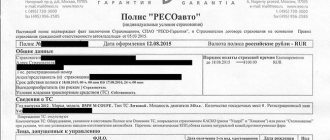Registration of compulsory motor liability insurance for legal entities
What does having an MTPL policy provide for legal entities:
- Uninterrupted operation of the company's fleet
- No expenses such as paying fines for not having a compulsory motor liability insurance policy
- In the event of an insured event, financial expenses, within the framework of the MTPL agreement, will be paid by the insurance company
- If an organization complies with the norms of current legislation, then this raises the company’s rating, increases the company’s development potential and the number of partners willing to interact and cooperate with such an organization, and as a result, leads to an increase in the company’s profits.
Fine for not having a compulsory motor liability insurance policy
The law obliges every car owner to purchase a MTPL contract and only then start driving a vehicle.
The state has established 2 types of fines:
- 500 rubles: charged if the car is not insured at all.
- 800 rubles: provided for when driving a vehicle with an expired MTPL agreement.
So, the MTPL policy is an important document for legal entities that use various types of vehicles. Applying for compulsory motor liability insurance for an organization is a little more difficult than for an individual. In addition, there are a number of features in the procedure and the use of insurance. It is important to know the calculation formulas and collect the necessary package of documents. But there is a positive point: compulsory motor liability insurance for legal entities can significantly reduce costs in case of an accident.
The advantage of working with us for legal entities
Nowadays, the most important requirements from clients are clarity, efficiency, and quality of services provided. The specialists of our company possess all these qualities. When issuing an MTPL policy for legal entities, our company works directly with insurance companies. That is, the legal entity that is the owner of the vehicle transfers the insurance premium for the MTPL policy directly to the insurance company’s bank account.
When paying for an MTPL policy for legal entities, both now and in 2021, it will be possible to pay both in cash and by bank transfer to the insurance company itself. That is, the organization that owns the insured vehicle chooses the type of payment for the insurance premium for the MTPL policy. Services for issuing an MTPL policy are provided for vehicles of all categories and for all regions of the Russian Federation. Our company insures vehicles of all categories: A, B, C, D, special equipment, regardless of the place of registration of the organization's legal address.
All issued MTPL policies are official. Our company issues MTPL policies that are registered in the RSA database (RSA-Russian Union of Auto Insurers).
Basic MTPL tariffs for legal entities 2021
Legal entities have their own basic tariffs for MTPL policies, which are determined by the central bank. The tables below show the current tariffs for leading insurance companies.
| Insurance Company | Basic tariff |
| AlfaInsurance | 2058 |
| Renaissance Insurance | 2058 |
| MAX | 2058 |
| Ingosstrakh | 2058 |
| Rosgosstrakh | 2058 |
| EUROINS | 2058 |
| TRUE | 2058 |
| USC | 2058 |
| GAYDE | 2058 |
| Zetta Insurance | 2058 |
| VSK | 2911 |
| Agreement | 2830 |
| Tinkoff Insurance | 2911 |
Calculation of the cost of compulsory motor liability insurance for legal entities
If you don’t know how much insurance for your car will cost, and the car is registered to a legal entity, then our calculator will help you correctly calculate the cost of the policy.
Calculation for all insurance
Enter the data once and calculate the cost of the MTPL policy for all top insurance companies.
Base rates
Always up-to-date base rates for all insurance companies, for all types of owner.
Online OSAGO
You can quickly apply for an MTPL policy online through our platform. Guarantee of official registration of the policy.
HTML for your site
When calculating the cost of a policy for legal entities, base rates are used - this is what the calculation of the policy begins from. All coefficients of the legal entity are multiplied by the base rate. Below is a list of basic rates that apply to legal entities when taking out a compulsory motor liability insurance policy.
| Owner type | Vehicle type | Base rate minimum|maximum rub. |
| Entity | Cars | 2573 | 3087 |
| Entity | Passenger taxis | 5138 | 6166 |
| Entity | Buses for regular transport | 5138 | 6166 |
| Entity | Buses with more than 16 seats | 3509 | 4211 |
| Entity | Buses up to 16 seats inclusive | 2808 | 3370 |
| Entity | Trucks up to 16 tons | 3509 | 4211 |
| Entity | Freight over 16 tons | 5284 | 6341 |
| Entity | Motorcycles and mopeds | 867 | 1579 |
| Entity | Tractors | 1124 | 1579 |
| Entity | Trams | 1751 | 2101 |
| Entity | Trolleybuses | 2808 | 3370 |
KBM discount for legal entities
The main condition for obtaining an MTPL policy for legal entities is insurance without restrictions. Drivers authorized to drive the insured vehicle are not included in the MTPL policy for legal entities. KBM is the bonus-malus coefficient, which is responsible for accident-free driving. For legal entities, the value of the KBM is determined by the number of insured events registered in the RSA database on the insured vehicle. KBM is the only coefficient from the value of which the cost of a compulsory motor liability insurance policy for a legal entity can be reduced (in the case of accident-free use of the vehicle).
OSAGO: documents for legal entities
Rice. 1 Documents: OSAGO for legal entities
To obtain an MTPL policy for legal entities, the following documents are required:
- 1. Certificate of registration of a legal entity
- 2. Card for recording basic information about the organization (contains basic information about the organization)
- 3. Certificate of registration with the tax authorities of a legal entity
- 4. STS (vehicle registration certificate) or PTS (vehicle passport) for the vehicle
- 5. Diagnostic vehicle inspection card contained in the EAISTO RSA database: EAISTO - Unified Automated Information System for Technical Inspection; RSA – Russian Union of Auto Insurers
- 6. The MTPL policy for legal entities is issued for an unlimited number of persons admitted to transport management. The organization itself decides which employee will be allowed to drive a truck. It is only necessary for an employee authorized to drive a vehicle to have not only a driver’s license, but also the corresponding category in the driver’s license.
- 7. When applying for a compulsory motor liability insurance policy for a legal entity, the presence of a trailer on the vehicle must be specified. The presence of a cargo trailer increases the cost of the MTPL policy by 25%. Separate MTPL for a cargo trailer is not issued.
Required documents
To obtain a policy for an organization, its representative will need the following list of documents:
- personal passport;
- power of attorney certified by the director;
- certificate of registration of a legal entity;
- TIN of the enterprise;
- PTS of cars for which insurance will be issued;
- title documents for each vehicle (sale/purchase/leasing/car loan agreement, etc.);
- a valid diagnostic card (if more than 3 years have passed since the production date of the car);
- previously issued insurance (if available).
Note! Organizations, like other car owners, can receive not only a paper, but also an electronic policy. The procedure for registration and the list of documents have no fundamental differences.
Difficulties in obtaining insurance for legal entities
Rice. 2 OSAGO legal entity
Difficulties in obtaining insurance by a legal entity arise when insuring vehicles of category C, D, since trucks and buses often become involved in road accidents, and compensation payments for damage are actually unprofitable. It is also possible for an insurance company to encounter a situation where, before issuing an MTPL policy, a car is sent for additional inspection to a special inspection platform located in the far Moscow region, and even a new vehicle that has just left the showroom is subject to inspection. At the same time, voluntary compulsory insurance of 10,000 rubles is not excluded. to the issued MTPL policy.
As we mentioned above, clarity and efficiency are very important for legal entities when arranging services, since downtime associated with long-term registration or re-issuance of documents is expensive for any organization.
Also in this section, we would like to note that in 2021, companies that provide per-minute car rental services (car sharing) have gained momentum very quickly. Since the service itself involves the provision of a car for money, the amount of which depends on the driving time, we can immediately conclude that the accident rate of such vehicles is very high. In this regard, many insurance companies refuse to provide MTPL policies for legal entities engaged in this business, which cannot be said about our company, where you can always take out a MTPL policy, regardless of the type of activity of your company.
Our company offers insurance to legal entities on the same day of application and in the shortest possible time. It is also possible to obtain insurance online, that is, authorized representatives of the company via Internet communications can send copies of the documents necessary for issuing an MTPL insurance policy to a legal entity, and our company’s courier service will deliver MTPL insurance to a legal entity at any convenient time and place established in advance agreements.
Contract time
The standard period of validity of an MTPL agreement, regardless of the status of the policyholder, is 1 year from the date of conclusion. But for legal entities, a different minimum period for issuing a policy is established.
Thus, organizations cannot insure a car for a period of less than six months, while an individual has the right to enter into an agreement for 3 months (for vehicles that are not intended for year-round use).
Types of insurance for legal entities
Rice. 3 Types of insurance for legal entities
In accordance with current legislation, an MTPL policy for legal entities is issued for an unlimited number of drivers, that is, without restrictions. This norm is determined by the specifics of intensive use of a vehicle in an organization and the need for interchangeability of drivers. Thus, the organization itself decides who will be allowed to drive the vehicle. Here you need to pay attention to ensure that the employee not only has a valid driver’s license, but also the category indicated on the driver’s license corresponds to the category of the vehicle being driven. Moreover, when an insured event occurs, it is checked whether the driver in whose participation the accident occurred is officially employed by the organization.
The MTPL policy can be issued both on paper and in electronic form. There are no fundamental differences in what medium the OSAGO policy is issued on. Both policies are in the RSA database and have the same legal force.
Electronic MTPL for legal entities
In accordance with the global trend of transferring all services into electronic form, MTPL policies for legal entities are also issued electronically. At the same time, by issuing an electronic MTPL policy to the driver, the organization does not have to worry, as before, that the MTPL policy may be lost, since the electronic MTPL form can be printed as many times as desired, and if lost, there is no need to go to the insurance company to restore it . A special feature of issuing an MTPL policy for legal entities is the certification of the application for issuing a policy with an Electronic Digital Signature (EDS). The MTPL policy itself is signed with the digital signature of the head of the legal entity.
Which one to choose: electronic or paper?
Each vehicle owner makes his own decision. The main difference is that the OSAGO policy on paper is issued in a single copy with all degrees of protection, including holographic protection. An electronic MTPL policy for legal entities is issued with a mandatory electronic digital signature on the part of the legal entity. Our company issues compulsory motor liability insurance policies for legal entities on paper, but, taking into account the client’s wishes, also issues compulsory motor liability insurance policies in electronic form.
How much more expensive is MTPL insurance for a legal entity?
The calculation of the cost of an MTPL policy consists of the base rate and the coefficients applied to the base rate. The base rate for a legal entity is lower than the base rate for individuals and individual entrepreneurs. However, an MTPL policy for legal entities is always issued without restrictions, i.e. Any driver who has a valid driver's license of the appropriate category can be allowed to drive a vehicle. Therefore, the coefficient used to calculate the MTPL policy for a legal entity is taken at the maximum value. Accident rates are considered not by drivers, but by the number of accidents registered on a vehicle. Under such conditions, a compulsory motor liability insurance policy for a legal entity is at a cost higher than the cost of a compulsory motor liability insurance policy for individuals.
You can compare the cost of an MTPL policy for an individual and a legal entity using the example of a car - Hyundai Solaris, this is one of the most common cars now; for definiteness, we will assume that the owner of the car is registered in Moscow and has a CBM (discount) equal to 1.
Individual
| Owner | Individual |
| Vehicle type | Passenger cars |
| Power | 100 hp |
| Term | 1 year |
| Age and experience | Over 22, over 3 years |
| KBM | 1 |
| Region | Moscow |
From 8237 to 9883 rubles.
Entity
| Owner | Entity |
| Vehicle type | Passenger cars |
| Power | 100 hp |
| Term | 1 year |
| Age and experience | Over 22, over 3 years |
| KBM | 1 |
| Region | Moscow |
From 11115 to 13336 rubles.
We see that despite the fact that for legal entities the base rate is lower, however, due to the fact that insurance is unlimited, it is still about one and a half times more expensive. This is a common situation for legal entities. In general, this is logical, since if the car is registered to a legal entity, then any employee of the company can drive it, so it is necessary that all risks are taken into account in the price.
Is it possible to write out limited insurance for a legal entity?
In accordance with current legislation, taking into account the specifics of the activities of organizations, insurance is always issued for an unlimited number of drivers. This is convenient for both the organization and the insurance company. In practice, there is always staff turnover, so the number of specific drivers indicated in the MTPL policy for a vehicle is impractical for both the legal entity that owns the car and the insurance company. Thus, it is impossible to issue limited insurance to a legal entity.
Base rate
There are generally accepted MTPL tariffs for organizations and enterprises. They are installed in accordance with Art. 9 of the Law. The cost depends on the type of vehicle, technical parameters, and purpose. New rates for compulsory motor third party liability insurance are presented in the table.
| Type of vehicle | Size, rub. |
| Motorcycles and other vehicles of categories A, A1, M | from 867 to 1579 |
| Vehicles up to 3.5 tons, including with a trailer | from 2573 to 3087 |
| Taxi | from 5138 to 6166 |
| Vehicle category C, CE, weighing 16 tons or less | from 3509 to 4211 |
| Vehicles of category C, CE with a permissible weight exceeding 16 tons | from 5284 to 6341 |
| Car category D, DE (subject to availability of seats no more than 16) | from 2808 to 3370 |
| Car category D, DE (if there are 16 or more seats) | from 3509 to 4211 |
| Vehicles of category D, DE for regular transportation of people | from 5138 to 6166 |
| Trolleybus | from 2808 to 3370 |
| Tram | from 1751 to 2101 |
| Special equipment on wheels | from 1124 to 1579 |
In addition to the base rate, the following coefficients are applied: territorial, bonus-malus (can be either increasing or decreasing), vehicle power, for use with a trailer, taking into account the experience and age of the driver, and others.
Important questions
Fine for lack of compulsory motor liability insurance for legal entities
The absence of a compulsory motor liability insurance policy for a vehicle owned by a legal entity entails a fine. The amount of the fine is established by Article 12.37 of the Code of the Russian Federation on Administrative Offenses. Clause 1 of Article 12.37 (driving a vehicle by a driver not included in the MTPL policy) provides for a fine of 500 rubles. Clause 2 of Article 12.37 (lack of compulsory motor liability insurance policy) provides for a fine of 800 rubles. Considering that an MTPL policy for legal entities is always issued for an unlimited number of drivers, for legal entities a fine is possible for the lack of an MTPL policy in the amount of 800 rubles. Here we must not forget that if the MTPL policy is issued in electronic form, then the absence of its image on paper does not entail the imposition of a fine. A traffic police officer can see its presence on a specific vehicle in the RSA database.
Registration of an MTPL policy by power of attorney (legal entity)
An MTPL policy for a vehicle owned by a legal entity is issued on the basis of a power of attorney. A power of attorney is a document that describes the powers transferred from the principal to the authorized person. All actions permitted to the authorized person, his powers (concluding an insurance contract, making changes to the MTPL policy, receiving insurance payment in the event of an insured event, representing the interests of the principal in court) must be specified in the power of attorney. Otherwise, the power of attorney cannot be used. The authorized person must be over 18 years old and have a passport, the details of which are indicated in the power of attorney. On the part of the legal entity, the registration data of the organization and data on the vehicle subject to car insurance are entered. The validity period of the power of attorney is indicated. If the validity period of the power of attorney is not specified, then 1 year is automatically accepted. The power of attorney is certified by signatures and seals, or, if necessary, executed by a notary.
Payments under MTPL to legal entities
In order to receive payments under compulsory motor liability insurance, you must not only have a compulsory motor liability insurance policy that is valid at the time of the insured event, but also carry out the entire algorithm of actions correctly: The driver of the vehicle must stop, turn on the hazard warning lights, and do not leave the scene of the accident/accident until arrival of traffic police officers;
Call the insurance company, notify about the occurrence of an insured event (the name of the insurance company and the contact telephone number of the hotline are indicated in the upper left corner), describe the situation and receive recommendations in connection with the occurrence of an insured event and a list of all necessary documents; If there are victims, be sure to call an ambulance;
Call a traffic police officer, draw up a protocol, or if there are no disagreements between the participants in the accident, there are no victims, the damage is up to 100,000 rubles, by agreement of the parties, fill out the accident notification form (“Euro protocol”) in two copies.
Within 5 working days, a representative of a legal entity (with a valid power of attorney) must contact the insurance company with a written application and attaching all the necessary documents for the legal entity, copies of the MTPL policy, documents drawn up by traffic police specialists (notification of an accident, certificate from the traffic police, protocol administrative offense/refusal to initiate an administrative offense) or notification of an accident (European protocol) - if traffic police officers were not involved. On the copy of the application to the insurance company, it is necessary for the insurance company specialists to indicate the incoming number and date of reception. Next, the vehicle is inspected by an expert from the insurance company and issues a conclusion. Within 20 days, the insurance company makes a decision on compensation for damage. The procedure for compensation for damage, including for legal entities, in the event of an insured event has been changed from April 2021. Now funds are received at service stations that have entered into agreements with insurance companies, and the vehicle is repaired directly from the insurance company within the scope of damage approved by the insurance company. The renovation should be completed within a month. The maximum amount insured in 2021 upon the occurrence of an insured event for damage compensation is 400,000 rubles, and for health compensation is 500,000 rubles.
Terms of insurance for legal entities
Our company will issue an MTPL policy to a legal entity on the day of application within an hour, taking into account all the data and discounts established by current legislation and contained in the RSA database. It is advisable to call first and clarify the list of necessary documents, select an insurance company, find out the cost of the MTPL policy for a specific vehicle, and the terms of insurance.
Base rates
The basis for any calculation of the cost of an MTPL policy is the base rate, which is set by each insurance company individually within the limits established by the Bank of Russia, which at the federal level controls the amount of insurance premiums when issuing MTPL policies. For each category of vehicle, its own base rate is approved, which depends on the technical features, design of the vehicle, the possible likelihood of damage caused by the insured vehicle, as well as who owns the vehicle: an individual or a legal entity.
Coefficients for legal entities
The coefficients used when calculating the MTPL policy are uniform throughout the Russian Federation and are mandatory for use by all insurance companies. The Bank of Russia controls this process on the basis of Article 8 of the federal insurance law. The cost of an MTPL policy consists of the base rate for a specific vehicle and the application of coefficients to the base rate. Let's look at the coefficients used for legal entities.
- The vehicle type coefficient is selected according to vehicle categories and operating conditions.
- The coefficient responsible for the presence of a trailer increases the cost of the MTPL policy by 25%, since the trailer is not insured separately. But the inspection of the trailer is carried out separately from the vehicle.
- The power factor is gradated by horsepower: the power can be clarified in the documents for the vehicle: STS or PTS.
- Coefficient specifying the term of the contract: 1 year is indicated here.
- The vehicle use period coefficient determines how many months the vehicle is insured for.
- The KBM coefficient is responsible for trouble-free driving. For legal entities, taking into account that insurance is always provided without restrictions (not tied to specific drivers), the MSC is established based on the presence of an accident involving a specific vehicle. This coefficient is taken from the unified RSA database.
- The region coefficient for legal entities is determined not by the place of specific operation of the vehicle, but by the region where the organization that owns the insured vehicle is legally registered.
Fines
In the absence of a compulsory motor liability insurance policy for legal entities in 2021, a fine will be imposed. Its size is 800 rubles. If a vehicle owned by a legal entity has an issued MTPL policy, but the driver driving a vehicle owned by a legal entity does not have the MTPL policy (the form itself) with him, then the fine is 500 rubles.
Compulsory civil liability insurance for vehicle owners is a civilized way to protect the interests of road users.
The vehicle must be insured regardless of who the owner is: an individual or a legal entity.
The life of those legal entities who neglect to have insurance on their cars will become much more difficult in 2021, as a new type of cameras will be introduced - which record the presence of insurance on cars, so the number of fines may increase significantly.
Compensation upon occurrence of an insured event
The insurance payment procedure is the same as for other car owners. To receive compensation you need:
- notify the insurer and traffic police officers about the car accident;
- do not change the location of the cars until the arrival of the traffic police and a representative of the insurance company;
- submit an application to the insurance company for damages within 5 days from the date of the accident;
- receive compensation in the form of cash or payment for repair work.
Note! In most cases, the second option for compensation for damage is possible (with the exception of the complete loss of the car). In this case, the service station is chosen by the insurer itself; an independent contact with the specialist will become the basis for refusal of payment.
If the participants in the accident have no disagreement about guilt, the damage was caused only to property, and the number of cars is no more than two, the parties can do without calling the State Traffic Inspectorate by drawing up a Europrotocol.
The payment amounts for legal entities are standard:
- up to 400 thousand rubles for damage to property;
- up to 500 thousand rubles if there are victims.
Features of insurance for legal entities
If a vehicle is registered to an organization, company (legal entity), then according to the legislation of the Russian Federation, the vehicle must be insured by an insurance company accredited by the RSA (Russian Union of Auto Insurers), since the legal entity bears full responsibility for the property it owns. according to statutory obligations. All vehicles owned by the organization must be promptly insured.
There are nuances of insurance for all legal entities:
1. The base rate when calculating the MTPL policy for legal entities differs from the base rate of the MTPL policy for individuals;
2. The minimum period for which a compulsory motor liability insurance policy is issued for legal entities is 6 months;
3. The MTPL policy for legal entities is issued for an unlimited number of persons who have the right to access to drive a vehicle registered in the name of a legal entity. That is, the organization, as a legal entity, after issuing an MTPL policy for a legal entity, itself determines the employees who will have access to driving the vehicle. A prerequisite in this case will be the presence of a valid driver's license for this category of vehicle for those authorized to drive a vehicle.
Thus, each organization must insure the vehicle and allow only persons with a valid driver's license to drive it - this is the area of responsibility of the legal entity. When operating a vehicle owned by a legal entity, the driver driving the vehicle must have a valid MTPL policy. Otherwise, if the driver driving the vehicle does not have an MTPL policy, then when stopped by a traffic police officer, a fine will be issued.
4. When calculating the cost of an MTPL policy, the territorial coefficient for a vehicle owned by a legal entity is taken at the place of registration of the owner - organization, as indicated in the Unified State Register of Legal Entities (USRLE - Unified State Register of Legal Entities).
5. The value of the BBM (bonus-malus) coefficient, i.e. indicator of accident-free driving, when calculating the cost of the MTPL policy, it is applied to each car separately, depending on the history of the car with the legal entity.
We also draw the attention of legal entities insuring vehicles owned by the organization to the fact that the calculation of the MTPL policy is the same for all insurance companies. All parameters involved in calculating the MTPL policy for a legal entity are the same. The difference in the cost of a compulsory motor liability insurance policy among different insurance companies is influenced by the base rate approved by the insurance company for calculating the compulsory motor liability insurance policy for legal entities.
Policy cost
When calculating compulsory motor liability insurance, several different basic tariff rates (BT) are taken as a basis:
- for passenger cars 2573-3087 rubles;
- for taxi services 5138-6166 rubles;
- for cars with a trailer 1.16;
- for trucks up to 16 tons – 1.4;
- for trucks over 16 tons - 1.25.
In addition, the following correction factors are used in the calculation:
- coefficient of the number of drivers (KO) – 1.8 (for legal entities this rate is constant);
- territorial coefficient (CT), determined depending on the region;
- bonus-malus coefficient (BMC) – traffic without an accident;
- engine power factor in horsepower (HP);
- coefficient per trailer (Kpr).
Based on the above, the cost of the policy for legal entities. persons is calculated using the following formula:
Cost of MTPL = BS×KT×KBM×KO×KM×KPR.
Compulsory motor insurance for legal entities in 2021
So, in the end, let's move on to a more pressing topic regarding compulsory motor insurance for legal entities in 2021. The situation here is as follows. The fact is that the Central Bank has planned innovations that will liberalize the receipt of compulsory motor insurance policies. Simply put, from 2021, the cost of policies will be calculated for each policyholder individually, which is great news for individuals.
Unfortunately, as you and I already know, for legal entities, compulsory motor insurance policies are issued only for an unlimited number of drivers allowed to drive. Therefore, compulsory motor insurance for legal entities in 2021 will not be calculated according to individual coefficients.
However, do not be upset, because there will also be positive changes in the field of compulsory motor insurance for legal entities in 2021. They will be the preservation of KBM after a break in insurance. That is, now, in the case of an accident-free history, a legal entity accumulates a certain KBM, which reduces the cost of the policy. However, in the event of a break in insurance, for example, a year, the KBM will be reset to zero and the entire history will be erased. When calculating the MTPL policy for legal entities in 2021, if a situation arises in which the transport will not be insured for any period of time, the CBM will still be the same.
How to apply: step-by-step instructions
To obtain insurance you need:
- find a suitable insurance company;
- prepare documentation and submit it;
- receive ready-made policies.
When receiving completed papers, they must be checked very carefully for correctness of completion and accuracy of information. If errors or inaccuracies are found, you should notify your insurance agent so that changes and amendments can be made. It should be remembered that the insurance policy is a strict reporting form and making changes to it by hand or in any other similar way is strictly prohibited.
To make changes to the policy, the damaged form is canceled , and the insurance agent gives the client another form with the changes made to it. These actions are mandatory, because driving with incorrectly executed documents entails penalties. More details about how changes are made to the MTPL insurance policy can be found here.
After issuing the MTPL policy, the company representative is given the originals of all documents, the original insurance policy, and a receipt for payment of the insurance.
Tariffs and calculations
When drawing up a CASCO agreement for legal entities, a different type of policy is used, in which the amount of the insurance payment is not taxed.
The cost of an insurance policy for a company at the base rate is affected by the following coefficients:
- Kps – insurance period;
- Kv – number of admitted drivers;
- Xow – a method for determining damage;
- Krps – model of a radio search system;
- Kfr – franchise volume;
- KBT – break-even type of insurance;
- Kpu – previous losses;
- Kras – payment method or installment plan;
- Kpark – insurance of the entire vehicle fleet at the same time;
- Kvbs – payments without providing certificates;
- Kss – type of sum insured.
In addition to the use of coefficients, the cost of a CASCO policy is influenced by the following indicators:
- Details of the insured vehicle – make, model, year of manufacture, etc.
- The market value of the vehicle at the time of drawing up the contract.
- Number of horsepower and total weight of the vehicle.
- Vehicle registration address.
- The presence or absence of an anti-theft system.
- Minimum driving experience of prospective drivers.
- Category of the insured vehicle.
For example, the basic tariff for category B passenger cars ranges from 2,570 to 3,080 rubles. For cars used as taxis from 5140 to 6165 rubles.











